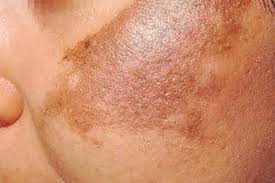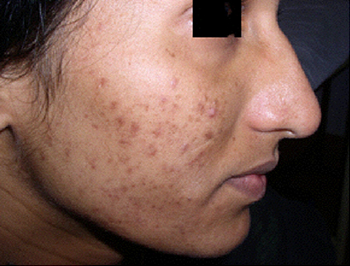Just to warn you all….this is a very detailed post…you may need a good strong cup of tea or coffee before reading any further….
I receive so very many enquiries and calls for help from customers who suffer some form of pigmentation. This is one of the most troubling and hardest to deal with of all skin imperfections and causes understandable frustration and upset for those dealing with it. So hence the creation of this post which I’m hoping will help sufferers understand their condition…the why and how…and also the best possible way to eradicate this condition from their skin once and for all.
Melasma is a tan or dark skin discolouration. Although it can affect anyone, it is particularly common in women, especially those who are pregnant or taking oral contraceptives/HRT. Melasma is thought to be the stimulation of Melanocytes, which produce Melanin, by the female sex hormones Estrogen and Progesterone to produce more Melanin pigments when the skin is exposed to sun. Melasma can also occur as a genetic predisposition as well as occasionally occurring in those who suffer from thyroid disease.
Chloasma, although similar to Melasma, is normally induced by pregnancy hormones…
Pigmentation on the other hand usually occurs from either sun damage or post inflammation (those with acne may find they are left with pigmented acne scars long after the spot itself has healed).
Safe treatment of any of these conditions should not involve bleaching or lightening the affected areas of skin, as products that do this often contain dangerous or toxic ingredients (such as hydroquinone or mercury).
People are aware that the skin sheds and replaces itself continuously over a 28 day period but, as we age, this turnover process slows and by the age of 50 may take as long as 3 months. So if the skin is continuously replaced the why do the blemishes remain? As new cells are formed in the lower levels they move up through those layers and eventually replace the dead cells above them. As they move up they push the cells above them towards the surface, until reaching the very top, they are shed. The new cells inherit the characteristics of the old cells above them as they complete their journey. This duplication means the new cells tend to inherit the damaged characteristics of the cells they are destined to replace…this also explains why scars remain.
Effective treatment does not target the currently blemished layer of skin. The approach is to intervene in the duplication process so that the new layers of skin cells do not inherit the characteristics of the damaged layer. By targeting the enzyme which triggers melanin production (Tyrosinase) we can prevent the excess production of Melanin.
As you can see, any effective, long term treatment will take at least a month to begin to show effects (the time required for one complete skin shedding cycle) and the older you are the longer it may take for you to begin seeing results. Frustrating understandably…but if it works then it is quite possible that within just a few months time you will see a significant reduction in the intensity of colour of your pigmentation/melasma and, eventually, see it disappear altogether. A timely process but one that will work and see the end of a condition you may have spent years suffering from.
The process of replacing the surface layer with a new layer can be accelerated with the employment of a chemical peel. Chemical peels dissolve the bonds that hold the surface layer in place and allow it to be shed much more quickly. So using a mild chemical peel in conjunction with a Melanin inhibiting cream can be a highly effective combination. Typically more effective than using either a peel or a cream on it’s own.
We must also remember that the work carried out to reduce blemishes and pigmentation will be rendered useless if you fail to protect the skin from further stress and inflammation. An excellent sunscreen is needed daily, particularly if you are using a peel as part of your treatment.
Mandelic acid is an AHA (Alpha Hydroxy Acid). Mandelic is regarded as the mildest peel agent and is particularly recommended for Afro-American, African and Asian skin types. Mandelic’s particular propensity is for treating pigmented skin and is a popular choice for those experiencing sun damage induced hyper-pigmentation, melasma and chloasma.
Creams containing Niacinamide, Glucosamine, Liquorice extract, Mulberry extract and Sepiwhite, which all inhibit the enzyme that triggers Melanin production, are ideal accompaniments to a Mandelic peel. We also now have a peptide based active ingredient known as W220 and it is regarded as being the most effective ingredient currently on the market for treating pigmented skin. This active peptide is used in our Luminosa cream
We must also be aware that some ingredients that were previously used in products to treat pigmented skin…Kojic acid and Alpha-Arbutin…have now been deemed as unsafe. There is published evidence that Alpha-Arbutin converts to Hydroquinone – an ingredient so toxic that it is banned across the world for use in skin care preparations.
Hopefully this post may shed some light on Melasma, Chloasma and hyper-pigmentation as well as on the process of how the skin works and what is needed to interrupt the process of Melanin stimulants within the skin. In order to help with this we will be putting together two kits to deal with these skin issues…one that will contain a peel and one without and we will be offering these kits at a discounted price for our blog followers and for those who are members of Melasma Group on Facebook which can be found here. I was recently contacted by Abbey Ryan, a member of this group, who got me thinking about these kind of skin conditions and what we could do to help. The first port of call was to educate and inform…hence this blog post…and the second was to come up with the kits, which will be available to purchase on our website very soon.




